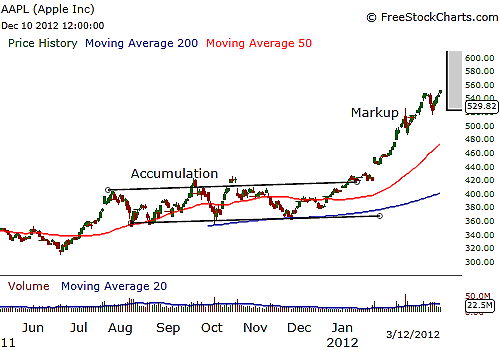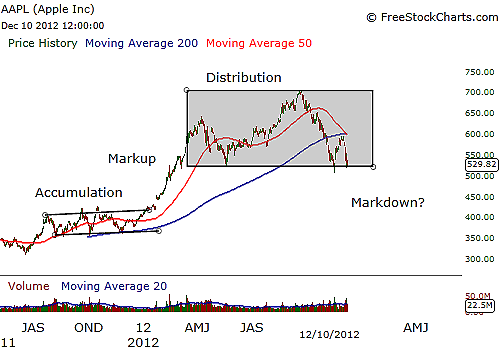
HOT TOPICS LIST
- MACD
- Fibonacci
- RSI
- Gann
- ADXR
- Stochastics
- Volume
- Triangles
- Futures
- Cycles
- Volatility
- ZIGZAG
- MESA
- Retracement
- Aroon
INDICATORS LIST
LIST OF TOPICS
PRINT THIS ARTICLE
by Billy Williams
The early 20th century gave us master traders who contributed greatly to the study of technical analysis, which is more relevant today than it has ever been.
Position: Sell
Billy Williams
Billy Williams has been trading the markets for 27 years, specializing in momentum trading with stocks and options.
PRINT THIS ARTICLE
TECHNICAL ANALYSIS
Wyckoff, Market Cycles, Working Models
12/17/12 08:19:12 AMby Billy Williams
The early 20th century gave us master traders who contributed greatly to the study of technical analysis, which is more relevant today than it has ever been.
Position: Sell
| Elite poker players who wage millions on each hand without so much as a flinch have attained a high level of understanding of the game from the ground up -- card counting, statistics, calculating the odds, risk/reward, and so on -- through sheer force of will and competitive drive that has brought them a high level of mastery and all the financial rewards that come with such skills. The road to mastery, however, is a winding road that goes uphill and is not for the faint of heart but for the tenacious and passionate, and intensely focused on the success of applying those kind of skills, not to mention the development of them as well. In the early 20th century, the market produced many elite traders and thinkers in development and application of elite trading skills and models, which produced unheard-of fortunes at the time, providing many profound lessons for aspiring traders even today. See Figure 1. |

|
| FIGURE 1: AAPL. Apple Inc. went through a lackluster trading range for most of the second half of 2011, where accumulation was taking place while the public lost interest in the stock. Later, the stock came alive during a markup period and the stock began to rise. |
| Graphic provided by: www.freestockcharts.com. |
| |
| Jesse Livermore, Charles Dow, and Bernard Baruch ranged from colorful to mysterious but whose insights and trading methods paved the way for modern technical analysis and, almost without exception, proved to be as reliable today as they were almost a century ago. One of the early innovators of technical analysis was Richard Wyckoff, a businessman and trader. During his lifetime, he had access to some of the most fertile trading minds of the early 20th century and formulated a method for measuring and identifying the buying and selling convictions of the overall market itself. This became known as the Wyckoff market cycle. |
| Richard Wyckoff was of the idea that the cycle was the direct result of institutional traders who planned their daily trading activity around exploiting the public's lack of trading sophistication and profiting from it. To detail this phenomenon, Wyckoff proposed a four-stage market cycle: |
| 1) Accumulation. Expressed as a sideways trading range where large players buy carefully with skill so that price doesn't gyrate wildly and alert the public that something is underfoot. This stealth buying/selling is very covert and, when pulled off successfully, the public is completely unaware that accumulation is taking place. 2) Markup. The is the classic uptrend where the bulls are firmly in control and price ebbs up and down in a steady series of higher highs and higher lows. The public may enter the market at this phase and cause greater acceleration in price's upward direction while the smart money is already in a firm position and may take advantage of new highs to lock in profits while the public's demand for the stock is high. 3) Distribution. This takes place as the bulls pass control of the stock to the bears and price falls flat just before the downtrend sets in. Sadly, a large part of the public will buy shares as price is falling because they are of the belief that the stock is a good value even as it continues to decline while the large players sell their position to them and turn around and short the market. The public gets squeezed between these two types of actions against them on the part of the large players. 4) Markdown. This is the downtrend that follows distribution and where some of the large players who were shorting the market just prior to this stage will now cover those shorts as price weakness sets in and lock in profits. Downward pressure grows and the public that has been hopeful of a bullish trend resumption start to panic and finally sell en masse at huge losses in the hope that they will be able to retain some of their net worth. See Figure 2. |

|
| FIGURE 2: AAPL. In 2012, AAPL pulled back and then attempted to go higher but it was short-lived. Price could not muster the strength to go higher, but the larger players used these rallies to sell into the stock's strength, causing a period of distribution to form. Will a markdown period follow as the fourth stage of the Wyckoff method dictates? |
| Graphic provided by: www.freestockcharts.com. |
| |
| This cycle is played out over and over again and it is relevant as ever because it is a symptom of human emotion. In a perfect world, the market is efficient and price finds a balance, but as human emotions get involved, they are ultimately reflected in extreme price action as they reach extreme levels themselves. The Wyckoff market cycle can help you avoid falling into those extremes and the downward spirals that they seem to inspire. Instead, it can help you stay on the right side of the market by helping you identify how the market is unfolding and, more important, to your benefit. |
Billy Williams has been trading the markets for 27 years, specializing in momentum trading with stocks and options.
| Company: | StockOptionSystem.com |
| E-mail address: | stockoptionsystem.com@gmail.com |
Traders' Resource Links | |
| StockOptionSystem.com has not added any product or service information to TRADERS' RESOURCE. | |
Click here for more information about our publications!
Comments

|

Request Information From Our Sponsors
- StockCharts.com, Inc.
- Candle Patterns
- Candlestick Charting Explained
- Intermarket Technical Analysis
- John Murphy on Chart Analysis
- John Murphy's Chart Pattern Recognition
- John Murphy's Market Message
- MurphyExplainsMarketAnalysis-Intermarket Analysis
- MurphyExplainsMarketAnalysis-Visual Analysis
- StockCharts.com
- Technical Analysis of the Financial Markets
- The Visual Investor
- VectorVest, Inc.
- Executive Premier Workshop
- One-Day Options Course
- OptionsPro
- Retirement Income Workshop
- Sure-Fire Trading Systems (VectorVest, Inc.)
- Trading as a Business Workshop
- VectorVest 7 EOD
- VectorVest 7 RealTime/IntraDay
- VectorVest AutoTester
- VectorVest Educational Services
- VectorVest OnLine
- VectorVest Options Analyzer
- VectorVest ProGraphics v6.0
- VectorVest ProTrader 7
- VectorVest RealTime Derby Tool
- VectorVest Simulator
- VectorVest Variator
- VectorVest Watchdog
